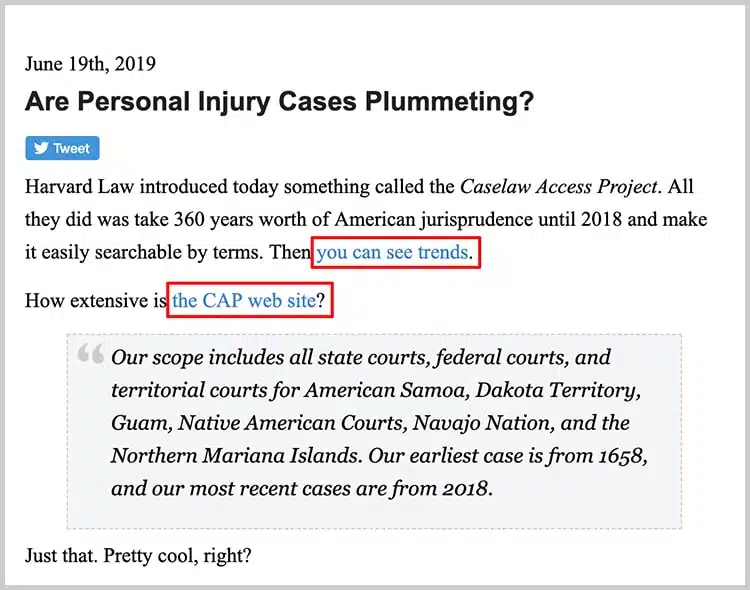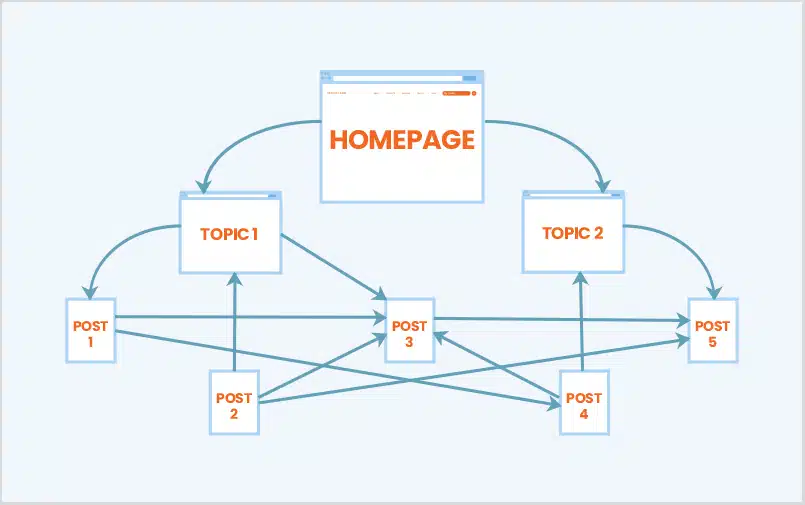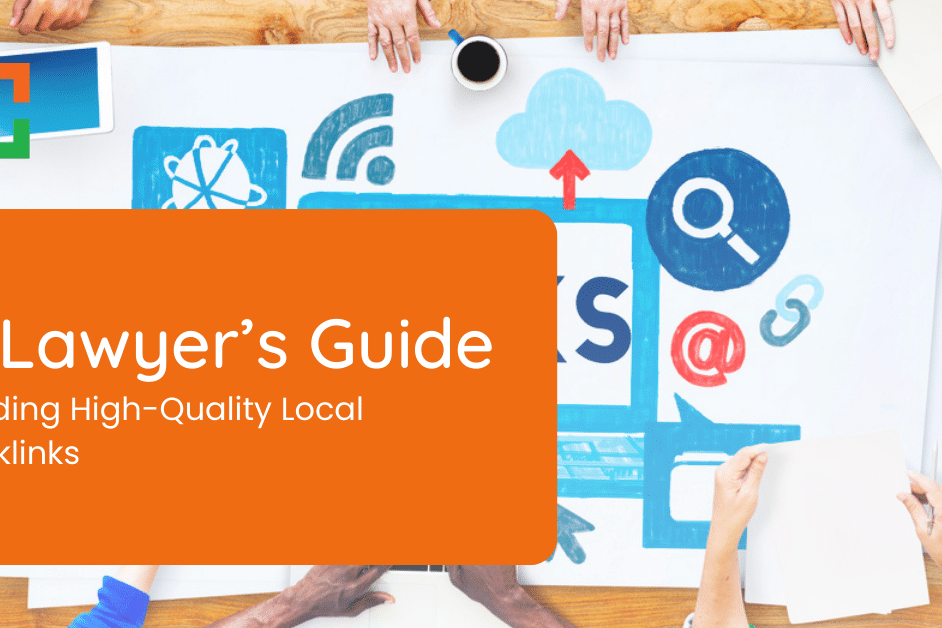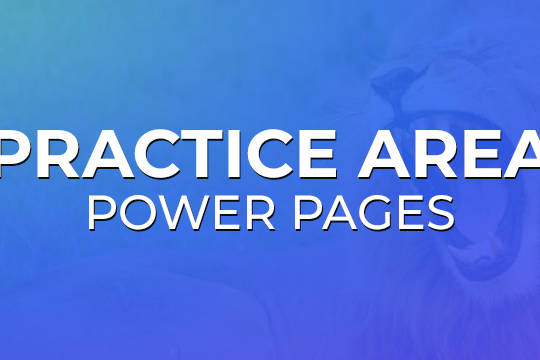Internal Links for Law Firm SEO: A Comprehensive Guide
Internal linking is essential to any successful law firm search engine optimization (SEO) strategy.
It involves creating links between different pages on your website, helping guide users and search engines through your content. It’s an essential way of helping Google crawl your website and improving how easy it is to navigate.
Plus, a well-executed internal linking strategy can improve your site’s usability, user engagement, and search engine rankings.
In this article, we’re going to go into the importance of internal links, how to create an effective strategy, and dive into best practices.
Table of Contents
Why internal links matter for law firm SEO
Internal links play a crucial role in helping search engines understand the structure of your website so that they can index your content more effectively.
It also improves the user experience (UX) by making it easy for website visitors to navigate your site and find what they’re looking for, like your consultation page.
Law firms can benefit greatly from a strong internal linking strategy, as it can:
- Boost your site’s authority and rankings
- Increase user engagement and dwell time
- Help search engines discover new content
- Encourage users to explore your site and convert
How to create an effective internal linking strategy for your law firm’s website
Creating an effective internal linking strategy involves careful planning and execution.
By following the steps outlined below, you can optimize your law firm’s website to improve search engine rankings and user experience.
Identify relevant content
The first step in creating an internal linking strategy is to take inventory of the content on your website.
This includes blog posts, practice area pages, FAQ pages, and any other informational resources.
To do this, you can:
- Perform a content audit: Review your existing content and categorize it based on topics, relevance, and target audience.
- Determine content gaps: Identify areas where additional content is needed to provide comprehensive information for your users.
- Create high-quality content: Develop new content that fills gaps and aligns with your law firm’s expertise and target keywords.
When you’re finished, you’ll have a list of all your existing content as well as a strategy for creating new content. From there, you can easily plan a cohesive and logical internal link structure based on relevance.
Choose anchor text wisely
Anchor text is the visible, clickable text used in a hyperlink.
When creating internal links, it’s essential to choose anchor text that accurately describes the linked content and is relevant to your target keywords.
Here are some tips for selecting effective anchor text:
- Be descriptive: Ensure your anchor text accurately represents the linked content, helping users understand what to expect when clicking the link.
- Use target keywords: When possible, incorporate your target keywords in the anchor text to signal relevance to search engines.
- Avoid generic phrases: Steer clear of using generic phrases like “click here” or “learn more” as anchor text, as they don’t provide any context for users or search engines.
Use natural language
When adding internal links to your content, use natural language and maintain a conversational tone.
This helps create a user-friendly experience and keeps your content engaging.
To achieve this, consider the following:
- Use personal pronouns: Speak directly to your readers by using personal pronouns like “you” and “we.”
- Keep sentences short and simple: Aim for clarity and readability by using shorter sentences and avoiding complex language.
- Incorporate rhetorical questions and metaphors: Engage your audience by using rhetorical questions and metaphors that resonate with them and help illustrate your points.
Maintain link hierarchies
An organized link hierarchy is essential for helping search engines understand the structure of your law firm’s website.
To maintain a clear hierarchy, consider the following:
- Link from higher-level pages to lower-level ones: Link from your homepage and main category pages to practice area pages and individual blog posts.
- Use breadcrumbs: Breadcrumbs are a navigational aid that helps users understand their location within your site’s structure. They also provide additional internal linking opportunities and improve site usability.
- Create a logical site structure: Organize your content into categories and subcategories that reflect the main topics and practice areas of your law firm.
By following these steps, you can create a well-organized internal linking strategy that benefits your users and search engine rankings.
Best practices for internal linking
Here are some of the best practices for internal linking.
Link deep
Deep linking refers to creating links that point to pages deeper within your site’s structure rather than only linking to top-level pages.
Deep linking has several benefits, including:
- Distributing link equity throughout your site: By linking to deeper pages, you can spread link equity across your website, improving the search engine ranking of lesser-known pages.
- Reducing bounce rate: Website visitors are more likely to stay on your law firm’s website if you link to deeper, relevant content.
Keep links relevant
Your internal links need to be relevant to the content they’re placed in.
- Link to related content: Choose internal links that are related to the legal content of the linking page and provide value to readers.
- Be mindful of context: Consider the context in which your internal link is placed, making sure it complements the surrounding content.
- Prioritize user experience: Always prioritize the user experience when creating internal links, and don’t just include links for SEO purposes.
Avoid over-optimization
While internal linking is essential for SEO, over-optimization can be detrimental.
To avoid over-optimization:
- Use a natural linking pattern: Instead of cramming multiple internal links into every piece of content, focus on creating natural links.
- Diversify anchor text: Refrain from using the same keyword-rich anchor text for multiple internal links.
Monitor and update your links regularly
A successful internal linking strategy requires ongoing maintenance and updates.
To keep your internal links fresh and effective:
- Perform regular link audits: Schedule periodic link audits to identify broken or outdated links and ensure that your internal linking structure remains functional and up-to-date.
- Update links when necessary: If you create new content that is more relevant or provides updated information, update your internal links accordingly to direct users to the most current and valuable resources.
- Analyze link performance: Use web analytics tools to monitor the performance of your internal links, identifying which links are driving user engagement and conversions and making adjustments as needed.
By implementing these best practices, you can create a robust internal linking strategy that improves your law firm’s website’s search engine rankings and overall user experience.
Internal linking tools and plugins
You can use several tools to track and enhance your internal linking strategy.
Consider these plugins:
- Yoast SEO: This popular WordPress plugin for SEO includes internal linking suggestions.
- Ahrefs: Ahrefs is an all-in-one SEO tool that can analyze your website’s internal links, identify broken links, and discover new linking opportunities.
- Screaming Frog: This powerful website crawler can identify broken links, analyze anchor text, and generate reports on your site’s internal linking structure.
Common mistakes to avoid
There are a few common mistakes people make when building their internal links.
- Excessive internal linking: While internal links are essential, including too many in your content can overwhelm users and may be seen as spammy by search engines. Focus on providing a few high-quality, relevant links instead.
- Using generic anchor text: Anchor text like “click here” or “learn more” doesn’t provide any context for users or search engines. Choose descriptive, keyword-rich anchor text that accurately represents the linked content.
Frequently Asked Questions
1. How many internal links should I include in my content?
There’s no one-size-fits-all answer to this question, as the ideal number of internal links will vary depending on your content’s length and complexity. Focus on providing high-quality, relevant links that enhance the user experience, rather than aiming for a specific number of links.
2. Can too many internal links hurt my SEO?
Excessive internal linking can be seen as spammy by search engines and may negatively impact your site’s rankings. Focus on providing a few high-quality, relevant links that genuinely benefit your users to avoid over-optimization.
3. How often should I audit my internal links?
The frequency of your internal link audits will depend on the size and complexity of your website. In general, it’s a good idea to perform an audit every six months to a year to ensure that your internal linking structure remains up-to-date and functional.
4. What’s the difference between internal linking and backlinking?
Internal linking refers to creating links between pages on your own website, whereas backlinking (also known as external linking) involves obtaining links from other websites that point to your site. Both internal and external links are essential for SEO, but they serve different purposes and require unique strategies.
Your law firm’s internal linking strategy will boost your SEO
As you now know, Internal linking is an important part of law firm SEO, helping to improve search engine rankings, user engagement, and overall website performance.
By following the best practices and avoiding common mistakes, you can start creating an an effective internal linking strategy that supports the growth and success of your law firm’s online presence.
Dennis Dimka
As the founder and CEO of Uptime Legal Systems, I've had the privilege of guiding our company to become a leading provider of technology services for law firms.
Our growth, both organic and through strategic acquisitions, has enabled us to offer a diverse range of services, tailored to the evolving needs of the legal industry.
Being recognized as an Ernst & Young Entrepreneur of the Year Finalist and seeing Uptime Legal ranked among the Inc. 5000 list of fastest-growing private companies in America for eight consecutive years are testaments to our team's dedication.
At Uptime Legal, we strive to continuously innovate and adapt in the rapidly evolving legal tech landscape, ensuring that law firms have access to the most advanced and reliable technology solutions.
Related Posts
March 8, 2024
Keyword Research for Lawyers: Choosing the Right Keywords to Get More Traffic and Leads
The ultimate guide to keyword research…
February 15, 2024
How Marketing Helps Law Firms Succeed: Strategies and Benefits
Explore the role of marketing in law…
January 30, 2024
SEO for Lawyers: A Beginner’s Guide (With 50+ Examples)
SEO for Lawyers is one of the best ways…
January 22, 2024
Why Should Businesses Optimize for Local SEO?
Discover which industries benefit most…
January 5, 2024
3 Pillars of Local SEO for Law Firms: Distance, Relevance, Prominence
Learn about the three most important…
December 28, 2023
The Lawyer’s Guide to Building Strong Local Backlinks
Learn about the importance of building…
December 7, 2023
Navigating Google’s Map Pack: A Law Firm’s Guide to Local SEO
Learn about Google's Map Pack, why your…
October 18, 2023
Local SEO for Lawyers: A Guide to Winning More Local Leads
Learn about the importance of local SEO…
May 30, 2023
SEO for Personal Injury Law Firms: A Complete Guide
Learn all about the power of personal…
March 23, 2023
Local Keyword Research for Lawyers: A How-To Guide
Learn all about the importance of local…
March 21, 2023
What Is Search Intent and Why Does It Matter for Law Firm SEO?
Learn all about search intent for law…
March 10, 2023
How SEO Compares to Other Law Firm Marketing Strategies
Learn about the importance of SEO for…
March 7, 2023
21 Ways to Attract More Backlinks to Your Law Firm’s Website
Learn about the importance of backlinks…
February 16, 2023
Local Citations for Law Firms: Maximizing Your Online Visibility
Learn what you need to know about local…
December 15, 2022
Google Business Profile for Lawyers: How to Skyrocket Your Local Search Leads (for Free)
Learn everything you need to know about…
April 4, 2022
SEO for Criminal Defense Lawyers: What You Need to Know
Even criminal defense law firms need to…
July 23, 2019
Practice Area Power Pages: 21 Tips to Get Your Service Pages to #1 in Google
All law firm's need practice area…



































